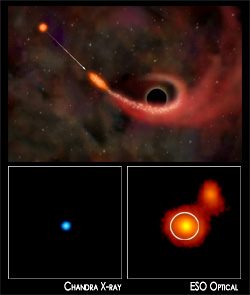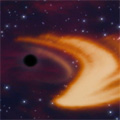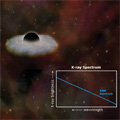February 18, 2004
NASA RELEASE: 04-061
Thanks to two orbiting X-ray observatories, astronomers have the first strong evidence of a supermassive black hole ripping apart a star and consuming a portion of it.
The event, captured by NASA's Chandra and ESA's XMM-Newton X-ray Observatories, had long been predicted by theory, but never confirmed.
Astronomers believe a doomed star came too close to a giant black hole after being thrown off course by a close encounter with another star. As it neared the enormous gravity of the black hole, the star was stretched by tidal forces until it was torn apart. This discovery provides crucial information about how these black holes grow and affect surrounding stars and gas.
"Stars can survive being stretched a small amount, as they are in binary star systems, but this star was stretched beyond its breaking point," said Stefanie Komossa of the Max Planck Institute for Extraterrestrial Physics (MPE) in Germany, leader of the international team of researchers. "This unlucky star just wandered into the wrong neighborhood."
While other observations have hinted stars are destroyed by black holes (events known as "stellar tidal disruptions"), these new results are the first strong evidence. Evidence already exists for supermassive black holes in many galaxies, but looking for tidal disruptions represents a completely independent way to search for black holes. Observations like these are urgently needed to determine how quickly black holes can grow by swallowing neighboring stars.
Observations with Chandra and XMM-Newton, combined with earlier images from the German Roentgen satellite, detected a powerful X-ray outburst from the center of the galaxy RX J1242-11. This outburst, one of the most extreme ever detected in a galaxy, was caused by gas from the destroyed star that was heated to millions of degrees Celsius before being swallowed by the black hole. The energy liberated in the process was equivalent to a supernova.
"Now, with all the data in hand, we have the smoking gun proof that this spectacular event has occurred," said coauthor Günther Hasinger, also of MPE.
The black hole in the center of RX J1242-11 is estimated to have a mass of about 100 million times Earth's Sun. By contrast, the destroyed star probably had a mass about equal to the Sun, making it a lopsided battle of gravity. "This is the ultimate David versus Goliath battle, but here David loses," said Hasinger.
The astronomers estimated about one percent of the star's mass was ultimately consumed, or accreted, by the black hole. This small amount is consistent with predictions that the momentum and energy of the accretion process will cause most of the destroyed star's gas to be flung away from the black hole.
The force that disrupted the star in RX J1242-11 is an extreme example of the tidal force caused by differences in gravity acting on the front and back of an object. The tidal force from the Moon causes tides in Earth's oceans. A tidal force from Jupiter pulled Comet Shoemaker-Levy apart, before it plunged into the giant planet.
The odds stellar tidal disruption will happen in a typical galaxy are low, about one in 10,000 annually. If it happened at the center of the Milky Way Galaxy, 26,000 light-years from Earth, the resulting X-ray outburst would be about 50,000 times brighter than the brightest X-ray source in our galaxy, beside the Sun, but it would not pose a threat to Earth.
Other dramatic flares have been seen from galaxies, but this is the first studied with the high-spatial resolution of Chandra and the high-spectral resolution of XMM-Newton. Both instruments made a critical advance. Chandra showed the RX J1242-11 event occurred in the center of a galaxy, where the black hole lurks. The XMM-Newton spectrum revealed the fingerprints expected for the surroundings of a black hole, ruling out other possible astronomical explanations.
In the future, searches using Chandra, XMM-Newton and survey instruments should find many other tidal disruptions. Detailed studies with future observatories like Constellation-X should teach us about the extreme physics around supermassive black holes.
NASA's Marshall Space Flight Center, Huntsville, Ala., manages the Chandra program for the Office of Space Science, NASA Headquarters, Washington. Northrop Grumman of Redondo Beach, Calif., formerly TRW, Inc., was the prime development contractor for the observatory. The Smithsonian Astrophysical Observatory controls science and flight operations from the Chandra X-ray Center in Cambridge, Mass. XMM-Newton is an ESA science mission managed at the European Space Research and Technology Centre (ESTEC) in the Netherlands for the Directorate of the Scientific Programme.
Additional information and images are available at:
MEDIA CONTACTS
Donald Savage
NASA Headquarters, Washington, DC
Phone: 202-358-1727
Guido De Marchi
ESA Science Communications, Netherlands
Intl. Phone: 31/71-565-3273
Megan Watzke
Chandra X-ray Observatory Center, CFA, Cambridge, MA
Phone: 617-496-7998
cxcpress@cfa.harvard.edu





